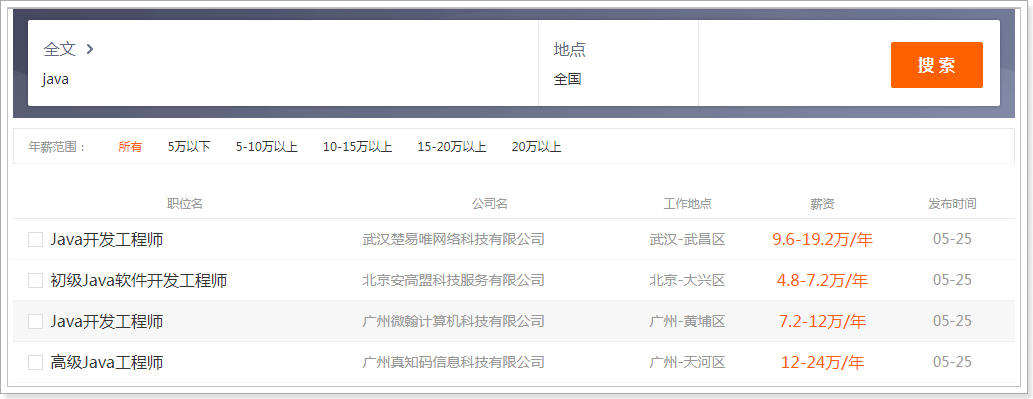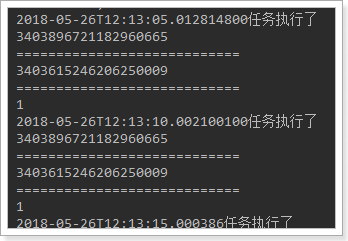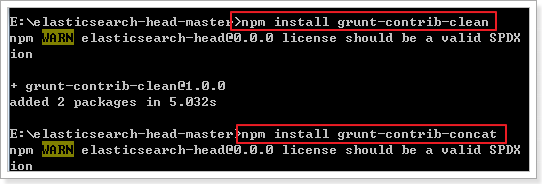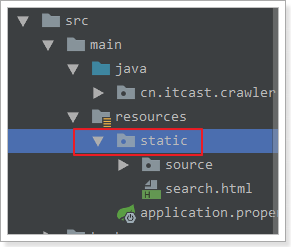网络爬虫
第三天
1 课程计划
- 案例扩展
- 定时任务
- 网页去重
- 代理的使用
- ElasticSearch环境准备
- Spring Data ElasticSearch回顾
- 完成ES基本使用
- 完成复杂查询
- 查询案例实现
2 案例扩展
2.1 定时任务
在案例中我们使用的是Spring内置的Spring Task,这是Spring3.0加入的定时任务功能。我们使用注解的方式定时启动爬虫进行数据爬取。
我们使用的是@Scheduled注解,其属性如下:
1)cron:cron表达式,指定任务在特定时间执行;
2)fixedDelay:上一次任务执行完后多久再执行,参数类型为long,单位ms
3)fixedDelayString:与fixedDelay含义一样,只是参数类型变为String
4)fixedRate:按一定的频率执行任务,参数类型为long,单位ms
5)fixedRateString: 与fixedRate的含义一样,只是将参数类型变为String
6)initialDelay:延迟多久再第一次执行任务,参数类型为long,单位ms
7)initialDelayString:与initialDelay的含义一样,只是将参数类型变为String
8)zone:时区,默认为当前时区,一般没有用到
我们这里的使用比较简单,固定的间隔时间来启动爬虫。例如可以实现项目启动后,每隔一小时启动一次爬虫。
但是有可能业务要求更高,并不是定时定期处理,而是在特定的时间进行处理,这个时候我们之前的使用方式就不能满足需求了。例如我要在工作日(周一到周五)的晚上八点执行。这时我们就需要Cron表达式了。
2.1.1 Cron表达式
cron的表达式是字符串,实际上是由七子表达式,描述个别细节的时间表。这些子表达式是分开的空白,代表:
- Seconds
2. Minutes
3. Hours
4. Day-of-Month
5. Month
6. Day-of-Week
7. Year (可选字段)
例 “0 0 12 ? WED” 在每星期三下午12:00 执行,
“” 代表整个时间段
每一个字段都有一套可以指定有效值,如
Seconds (秒) :可以用数字0-59 表示,
Minutes(分) :可以用数字0-59 表示,
Hours(时) :可以用数字0-23表示,
Day-of-Month(天) :可以用数字1-31 中的任一一个值,但要注意一些特别的月份
Month(月) :可以用0-11 或用字符串:
JAN, FEB, MAR, APR, MAY, JUN, JUL, AUG, SEP, OCT, NOV, DEC
Day-of-Week(天) :可以用数字1-7表示(1 = 星期日)或用字符口串:
SUN, MON, TUE, WED, THU, FRI, SAT
“/”:为特别单位,表示为“每”如“0/15”表示每隔15分钟执行一次,“0”表示为从“0”分开始, “3/20”表示表示每隔20分钟执行一次,“3”表示从第3分钟开始执行
“?”:表示每月的某一天,或第周的某一天
“L”:用于每月,或每周,表示为每月的最后一天,或每个月的最后星期几如“6L”表示“每月的最后一个星期五”
可以使用课堂资料的CronExpBuilder(表达式生成器)生成表达式
2.1.2 Cron测试
先把之前爬虫的@Component注解取消,避免干扰测试
//@Componentpublic class JobProcessor implements PageProcessor {
编写使用Cron表达式的测试用例:
@Componentpublic class TaskTest {
@Scheduled(cron = "0/5 * * * * *")<br /> public void test() {<br /> System._out_.println(LocalDateTime._now_()+"任务执行了");<br /> }<br />}
2.2 网页去重
之前我们对下载的url地址进行了去重操作,避免同样的url下载多次。其实不光url需要去重,我们对下载的内容也需要去重。
在网上我们可以找到许多内容相似的文章。但是实际我们只需要其中一个即可,同样的内容没有必要下载多次,那么如何进行去重就需要进行处理了
2.2.1 去重方案介绍
指纹码对比
最常见的去重方案是生成文档的指纹门。例如对一篇文章进行MD5加密生成一个字符串,我们可以认为这是文章的指纹码,再和其他的文章指纹码对比,一致则说明文章重复。
但是这种方式是完全一致则是重复的,如果文章只是多了几个标点符号,那仍旧被认为是重复的,这种方式并不合理。
BloomFilter
这种方式就是我们之前对url进行去重的方式,使用在这里的话,也是对文章进行计算得到一个数,再进行对比,缺点和方法1是一样的,如果只有一点点不一样,也会认为不重复,这种方式不合理。
KMP算法
KMP算法是一种改进的字符串匹配算法。KMP算法的关键是利用匹配失败后的信息,尽量减少模式串与主串的匹配次数以达到快速匹配的目的。能够找到两个文章有哪些是一样的,哪些不一样。
这种方式能够解决前面两个方式的“只要一点不一样就是不重复”的问题。但是它的时空复杂度太高了,不适合大数据量的重复比对。
还有一些其他的去重方式:最长公共子串、后缀数组、字典树、DFA等等,但是这些方式的空复杂度并不适合数据量较大的工业应用场景。我们需要找到一款性能高速度快,能够进行相似度对比的去重方案
Google 的 simhash 算法产生的签名,可以满足上述要求。这个算法并不深奥,比较容易理解。这种算法也是目前Google搜索引擎所目前所使用的网页去重算法。
2.2.2 SimHash
2.2.2.1 流程介绍
simhash是由 Charikar 在2002年提出来的,为了便于理解尽量不使用数学公式,分为这几步:
1、分词,把需要判断文本分词形成这个文章的特征单词。
2、hash,通过hash算法把每个词变成hash值,比如“美国”通过hash算法计算为 100101,“51区”通过hash算法计算为 101011。这样我们的字符串就变成了一串串数字。
3、加权,通过 2步骤的hash生成结果,需要按照单词的权重形成加权数字串,“美国”的hash值为“100101”,通过加权计算为“4 -4 -4 4 -4 4”
“51区”计算为 “ 5 -5 5 -5 5 5”。
4、合并,把上面各个单词算出来的序列值累加,变成只有一个序列串。
“美国”的 “4 -4 -4 4 -4 4”,“51区”的 “ 5 -5 5 -5 5 5”
把每一位进行累加, “4+5 -4+-5 -4+5 4+-5 -4+5 4+5”🡪“9 -9 1 -1 1 9”
5、降维,把算出来的 “9 -9 1 -1 1 9”变成 0 1 串,形成最终的simhash签名。 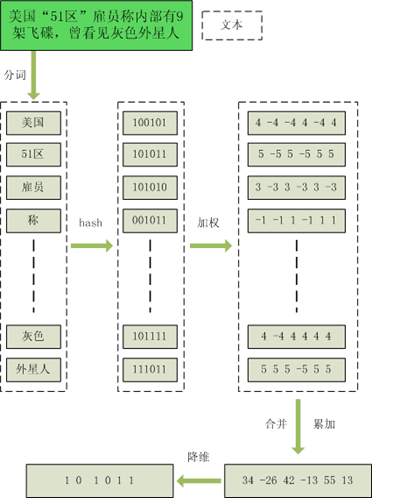
2.2.2.2 签名距离计算
我们把库里的文本都转换为simhash签名,并转换为long类型存储,空间大大减少。现在我们虽然解决了空间,但是如何计算两个simhash的相似度呢?
我们通过海明距离(Hamming distance)就可以计算出两个simhash到底相似不相似。两个simhash对应二进制(01串)取值不同的数量称为这两个simhash的海明距离。
举例如下: 10101 和 00110 从第一位开始依次有第一位、第四、第五位不同,则海明距离为3。对于二进制字符串的a和b,海明距离为等于在a XOR b运算结果中1的个数(普遍算法)。
2.2.2.3 导入simhash工程
参考项目:https://github.com/CreekLou/simhash.git
这个项目不能直接使用,因为jar包的问题,需要进行改造。这里使用课堂资料中已经改造好的。
导入工程simhash,并打开测试用例。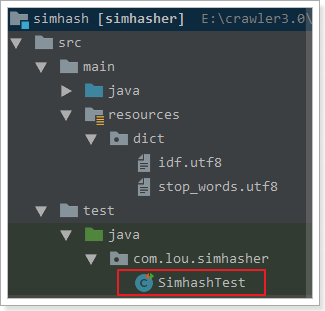
2.2.2.4 测试simhash
按照测试用例的要求,准备两个文件,就是需要进行对比的文章
执行测试用例,结果如下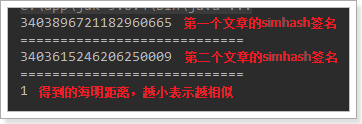
2.2.2.5 案例整合
需要先把simhash安装到本地仓库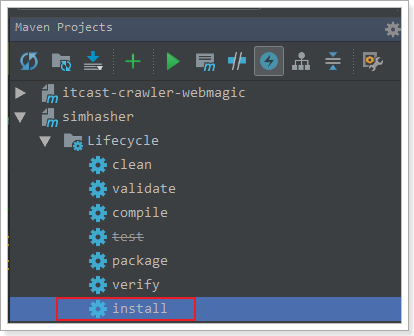
在案例的pom.xml中加入以下依赖
修改代码
@Componentpublic class TaskTest {
@Scheduled(cron = "0/5 * * * * *")<br /> public void test() {<br /> System._out_.println(LocalDateTime._now_()+"任务执行了");String str1 = _readAllFile_("D:/test/testin.txt");<br /> SimHasher hash1 = new SimHasher(str1);<br /> //打印simhash签名<br /> System._out_.println(hash1.getSignature());<br /> System._out_.println("============================");String str2 = _readAllFile_("D:/test/testin2.txt");<br /> //打印simhash签名<br /> SimHasher hash2 = new SimHasher(str2);<br /> System._out_.println(hash2.getSignature());<br /> System._out_.println("============================");//打印海明距离 System._out_.println(hash1.getHammingDistance(hash2.getSignature()));<br /> }public static String readAllFile(String filename) {<br /> String everything = "";<br /> try {<br /> FileInputStream inputStream = new FileInputStream(filename);<br /> everything = IOUtils._toString_(inputStream);<br /> inputStream.close();<br /> } catch (IOException e) {<br /> }<br /> return everything;<br /> }<br />}
2.3 代理的使用
有些网站不允许爬虫进行数据爬取,因为会加大服务器的压力。其中一种最有效的方式是通过ip+时间进行鉴别,因为正常人不可能短时间开启太多的页面,发起太多的请求。
我们使用的WebMagic可以很方便的设置爬取数据的时间(参考第二天的的3.1. 爬虫的配置、启动和终止)。但是这样会大大降低我们爬取数据的效率,如果不小心ip被禁了,会让我们无法爬去数据,那么我们就有必要使用代理服务器来爬取数据。
2.3.1 代理服务器
代理(英语:Proxy),也称网络代理,是一种特殊的网络服务,允许一个网络终端(一般为客户端)通过这个服务与另一个网络终端(一般为服务器)进行非直接的连接。
提供代理服务的电脑系统或其它类型的网络终端称为代理服务器(英文:Proxy Server)。一个完整的代理请求过程为:客户端首先与代理服务器创建连接,接着根据代理服务器所使用的代理协议,请求对目标服务器创建连接、或者获得目标服务器的指定资源。
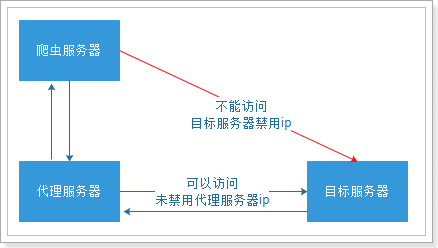
我们就需要知道代理服务器在哪里(ip和端口号)才可以使用。网上有很多代理服务器的提供商,但是大多是免费的不好用,付费的还行。
提供两个免费代理ip的服务商网站:
米扑代理
https://proxy.mimvp.com/free.php
西刺免费代理IP
http://www.xicidaili.com/
2.3.2 使用代理
WebMagic使用的代理APIProxyProvider。因为相对于Site的“配置”,ProxyProvider定位更多是一个“组件”,所以代理不再从Site设置,而是由HttpClientDownloader设置。
| API | 说明 |
|---|---|
| HttpClientDownloader.setProxyProvider(ProxyProvider proxyProvider) | 设置代理 |
ProxyProvider有一个默认实现:SimpleProxyProvider。它是一个基于简单Round-Robin的、没有失败检查的ProxyProvider。可以配置任意个候选代理,每次会按顺序挑选一个代理使用。它适合用在自己搭建的比较稳定的代理的场景。
如果需要根据实际使用情况对代理服务器进行管理(例如校验是否可用,定期清理、添加代理服务器等),只需要自己实现APIProxyProvider即可。
可以访问网址http://ip.chinaz.com/getip.aspx 测试当前请求的ip
为了避免干扰,把其他任务的@Component注释掉,在案例中加入编写以下逻辑:
@Componentpublic class ProxyTest implements PageProcessor {
@Scheduled(fixedDelay = 10000)<br /> public void testProxy() {<br /> HttpClientDownloader httpClientDownloader = new HttpClientDownloader();<br /> httpClientDownloader.setProxyProvider(SimpleProxyProvider._from_(new Proxy("39.137.77.68",80)));Spider._create_(new ProxyTest())<br /> .addUrl("http://ip.chinaz.com/getip.aspx")<br /> .setDownloader(httpClientDownloader)<br /> .run();<br /> }@Override<br /> public void process(Page page) {<br /> //打印获取到的结果以测试代理服务器是否生效<br /> System._out_.println(page.getHtml());<br /> }private Site site = new Site();<br /> @Override<br /> public Site getSite() {<br /> return site;<br /> }<br />}
3 ElasticSearch环境准备
3.1 安装ElasticSearch服务
课堂资料中的elasticsearch-5.6.8.zip进行解压
启动服务: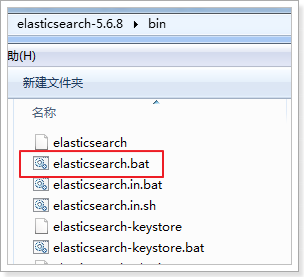
当出现以下内容表示启动完成
访问地址是http://127.0.0.1:9200 访问该地址:
表示ElasticSearch安装启动完成
3.2 安装ES的图形化界面插件
安装ElasticSearch的head插件,完成图形化界面的效果,完成索引数据的查看。采用本地安装方式进行head插件的安装。elasticsearch-5-*以上版本安装head需要安装node和grunt。
1)安装head插件
将head压缩包解压到任意目录,但是要和elasticsearch的安装目录区别开
2)安装nodejs
3)将grunt安装为全局命令 ,Grunt是基于Node.js的项目构建工具
在cmd控制台中输入如下执行命令:
npm install -g grunt-cli
效果如下: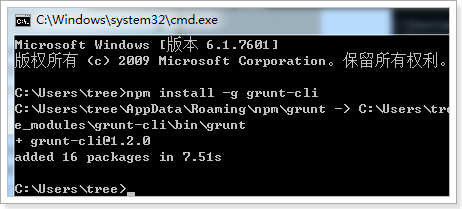
ps:如果安装不成功或者安装速度慢,可以使用淘宝的镜像进行安装:
npm install -g cnpm –registry=https://registry.npm.taobao.org
后续使用的时候,只需要把npm xxx 换成 cnpm xxx 即可
4)修改elasticsearch配置文件:elasticsearch.yml,增加以下三句命令:
http.cors.enabled: true
http.cors.allow-origin: “*”
network.host: 127.0.0.1
重启
5)进入head目录启动head,在命令提示符下输入命令:
grunt server
根据提示访问,效果如下:
PS:如果第5步失败,执行以下命令
npm install grunt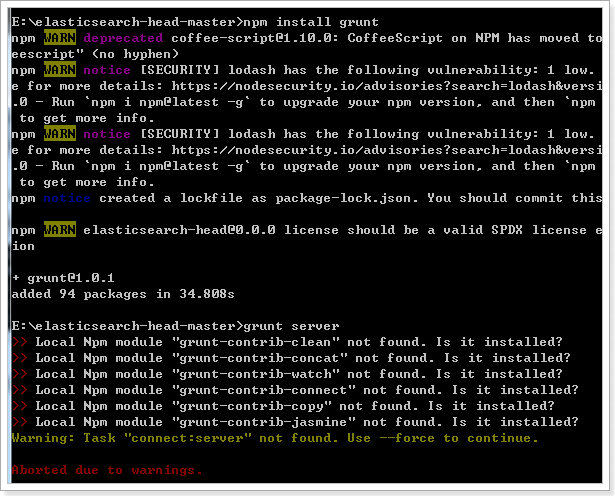
3.3 安装IK分词器
- IK分词器安装包在课堂资料

- 解压,将解压后的elasticsearch文件夹拷贝到elasticsearch-5.6.8\plugins下,并重命名文件夹为ik
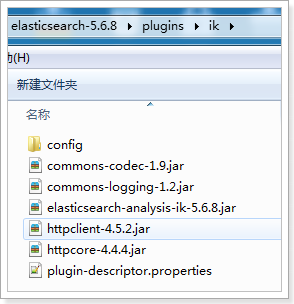
重新启动ElasticSearch,即可加载IK分词器
测试
在浏览器发起以下请求
1)最小切分:在浏览器地址栏输入地址
http://127.0.0.1:9200/_analyze?analyzer=ik_smart&pretty=true&text=我是程序员
浏览器显示
{
“tokens” : [
{
“token” : “我”,
“start_offset” : 0,
“end_offset” : 1,
“type” : “CN_CHAR”,
“position” : 0
},
{
“token” : “是”,
“start_offset” : 1,
“end_offset” : 2,
“type” : “CN_CHAR”,
“position” : 1
},
{
“token” : “程序员”,
“start_offset” : 2,
“end_offset” : 5,
“type” : “CN_WORD”,
“position” : 2
}
]
}
4 ElasticSearch回顾
4.1 创建Maven工程
创建Maven工程,给pom.xml加入依赖:
<?xml version=”1.0” encoding=”UTF-8”?>
xsi:schemaLocation=”http://maven.apache.org/POM/4.0.0 http://maven.apache.org/xsd/maven-4.0.0.xsd”>
<groupId>cn.itcast</groupId><br /> <artifactId>itcast-es</artifactId><br /> <version>1.0-SNAPSHOT</version><dependencies><br /> <dependency><br /> <groupId>org.elasticsearch</groupId><br /> <artifactId>elasticsearch</artifactId><br /> <version>5.6.8</version><br /> </dependency><br /> <dependency><br /> <groupId>org.elasticsearch.client</groupId><br /> <artifactId>transport</artifactId><br /> <version>5.6.8</version><br /> </dependency><br /> <dependency><br /> <groupId>org.apache.logging.log4j</groupId><br /> <artifactId>log4j-to-slf4j</artifactId><br /> <version>2.9.1</version><br /> </dependency><br /> <dependency><br /> <groupId>org.slf4j</groupId><br /> <artifactId>slf4j-api</artifactId><br /> <version>1.7.24</version><br /> </dependency><br /> <dependency><br /> <groupId>org.slf4j</groupId><br /> <artifactId>slf4j-simple</artifactId><br /> <version>1.7.21</version><br /> </dependency><br /> <dependency><br /> <groupId>log4j</groupId><br /> <artifactId>log4j</artifactId><br /> <version>1.2.12</version><br /> </dependency><br /> <dependency><br /> <groupId>junit</groupId><br /> <artifactId>junit</artifactId><br /> <version>4.12</version><br /> </dependency><br /> <dependency><br /> <groupId>com.fasterxml.jackson.core</groupId><br /> <artifactId>jackson-core</artifactId><br /> <version>2.8.1</version><br /> </dependency><br /> <dependency><br /> <groupId>com.fasterxml.jackson.core</groupId><br /> <artifactId>jackson-databind</artifactId><br /> <version>2.8.1</version><br /> </dependency><br /> <dependency><br /> <groupId>com.fasterxml.jackson.core</groupId><br /> <artifactId>jackson-annotations</artifactId><br /> <version>2.8.1</version><br /> </dependency><br /> <dependency><br /> <groupId>org.springframework.data</groupId><br /> <artifactId>spring-data-elasticsearch</artifactId><br /> <version>3.0.5.RELEASE</version><br /> </dependency><br /> <dependency><br /> <groupId>org.springframework</groupId><br /> <artifactId>spring-test</artifactId><br /> <version>5.0.4.RELEASE</version><br /> </dependency><br /> </dependencies>
添加配置文件applicationContext.xml
<?xml version=”1.0” encoding=”UTF-8”?>
xmlns:context=”http://www.springframework.org/schema/context“
xmlns:elasticsearch=”http://www.springframework.org/schema/data/elasticsearch“
xsi:schemaLocation=”http://www.springframework.org/schema/beans
http://www.springframework.org/schema/beans/spring-beans.xsd
http://www.springframework.org/schema/context
http://www.springframework.org/schema/context/spring-context.xsd
http://www.springframework.org/schema/data/elasticsearch
http://www.springframework.org/schema/data/elasticsearch/spring-elasticsearch-1.0.xsd”>
4.2 开发准备
4.2.1 编写pojo
public class Item {
private Integer id;<br /> private String title;<br /> private String content;<br />get/set<br />toString()}
4.2.2 编写dao
public interface ItemRepository extends ElasticsearchRepository
}
4.2.3 编写service
编写service接口
public interface ItemService {
}
编写service实现
@Servicepublic class ItemServiceImpl implements ItemService {
}
4.2.4 修改配置文件
<?xml version=”1.0” encoding=”UTF-8”?>
xmlns:context=”http://www.springframework.org/schema/context“
xmlns:elasticsearch=”http://www.springframework.org/schema/data/elasticsearch“
xsi:schemaLocation=”http://www.springframework.org/schema/beans
http://www.springframework.org/schema/beans/spring-beans.xsd
http://www.springframework.org/schema/context
http://www.springframework.org/schema/context/spring-context.xsd
http://www.springframework.org/schema/data/elasticsearch
http://www.springframework.org/schema/data/elasticsearch/spring-elasticsearch-1.0.xsd”>
<!-- 扫描Dao包,自动创建实例 --><br /> <elasticsearch:repositories base-package="com.itheima.dao"/><!-- 扫描Service包,创建Service的实体 --><br /> <context:component-scan base-package="cn.itcast.es.service"/><!-- 配置elasticSearch的连接 --><br /> <elasticsearch:transport-client id="client" cluster-nodes="localhost:9300"/><!-- spring data elasticSearcheDao 必须继承 ElasticsearchTemplate --><br /> <bean id="elasticsearchTemplate"<br /> class="org.springframework.data.elasticsearch.core.ElasticsearchTemplate"><br /> <constructor-arg name="client" ref="client"/><br /> </bean>
4.2.5 修改实体类
@Document(indexName = “item”, type = “item”)public class Item {
@Id<br /> @Field(index = true, store = true, type = FieldType._Integer_)<br /> private Integer id;<br /> @Field(index = true, store = true, analyzer = "ik_smart", searchAnalyzer = "ik-smart", type = FieldType._text_)<br /> private String title;<br /> @Field(index = true, store = true, analyzer = "ik_smart", searchAnalyzer = "ik-smart", type = FieldType._text_)<br /> private String content;public Integer getId() {<br /> return id;get/set<br />toString();<br />}
4.3 ElasticSearch基本使用
4.3.1 保存和修改文档
在pojo中设置了id为索引库的主键,索引根据id进行保存或修改。
如果id存在则修改,如果id不存在则更新
@RunWith(SpringJUnit4ClassRunner.class)@ContextConfiguration(locations = “classpath:applicationContext.xml”)public class SpringDataESTest {
@Autowired
private ItemService itemService; @Autowired
private ElasticsearchTemplate elasticsearchTemplate;
_/**<br /> * 创建索引和映射<br /> */<br /> _@Test<br /> public void createIndex() {<br /> this.elasticsearchTemplate.createIndex(Item.class);<br /> this.elasticsearchTemplate.putMapping(Item.class);<br /> }_/**<br /> * 测试保存文档<br /> */<br /> _@Test<br /> public void saveArticle() {<br /> Item item = new Item();<br /> item.setId(100);<br /> item.setTitle("测试SpringData ElasticSearch");<br /> item.setContent("Spring Data ElasticSearch 基于 spring data API 简化操作,实现搜索引擎功能");<br /> this.itemService.save(item);<br /> }_/**<br /> * 测试更新<br /> */<br /> _@Test<br /> public void update() {<br /> Item item = new Item();<br /> item.setId(100);<br /> item.setTitle("elasticSearch 3.0版本发布...更新");<br /> item.setContent("ElasticSearch是一个基于Lucene的搜索服务器。它提供了一个分布式多用户能力的全文搜索引擎,基于RESTful web接口");<br /> this.itemService.save(item);<br /> }<br />}
在ItemService中添加Service接口方法
/*
保存
@param item
_*/_void save(Item item);
在ItemServiceImpl添加Service实现方法
@Autowiredprivate ItemRepository itemRepository;
public void save(Item item) {
this.itemRepository.save(item);}
4.3.2 删除文档
在测试用例中SpringDataESTest中添加测试逻辑
/*
测试删除
/@Testpublic void delete() {
Item item = new Item();
item.setId(100);
this.itemService.delete(item);}
在ItemService中添加Service接口方法
/*
删除
@param item
_*/_void delete(Item item);
在ItemServiceImpl添加Service实现方法
public void delete(Item item) {
this.itemRepository.delete(item);}
4.3.3 批量保存
在测试用例中SpringDataESTest中添加测试逻辑
/*
批量保存
/@Testpublic void saveAll(){
List
for(int i=1;i<=100;i++){
Item item = new Item();
item.setId(i);
item.setTitle(i+”elasticSearch 3.0版本发布..,更新”);
item.setContent(i+”ElasticSearch批量插入”+i);
items.add(item);
}
this.itemService.saveAll(items);}
在ItemService中添加Service接口方法
/*
批量保存
@param items
_*/_void saveAll(List
在ItemServiceImpl添加Service实现方法
public void saveAll(List
this.itemRepository.saveAll(items);}
4.3.4 查询所有
在测试用例中SpringDataESTest中添加测试逻辑
/*
查询所有
*/@Testpublic void findAll(){
Iterable
for(Item article:list){
System.out.println(article);
}
}
在ItemService中添加Service接口方法
/*
查询所有
@return
_*/_Iterable
在ItemServiceImpl添加Service实现方法
public Iterable
Iterable
return items;}
4.3.5 分页查询
在测试用例中SpringDataESTest中添加测试逻辑
/*
分页查询
*/@Testpublic void findAllPage(){
Page
for(Item article:page.getContent()){
System.out.println(article);
}
}
在ItemService中添加Service接口方法
/*
分页查询
* @param page
__* @param rows
__* @return
_*/
_Page
在ItemServiceImpl添加Service实现方法
public Page
Page
return result;}
4.4 ElasticSearch复杂查询
4.4.1 查询方法示例
| 关键字 | 命名规则 | 解释 | 示例 |
|---|---|---|---|
| and | findByField1AndField2 | 根据Field1和Field2获得数据 | findByTitleAndContent |
| or | findByField1OrField2 | 根据Field1或Field2获得数据 | findByTitleOrContent |
| is | findByField | 根据Field获得数据 | findByTitle |
| not | findByFieldNot | 根据Field获得补集数据 | findByTitleNot |
| between | findByFieldBetween | 获得指定范围的数据 | findByPriceBetween |
| lessThanEqual | findByFieldLessThan | 获得小于等于指定值的数据 | findByPriceLessThan |
4.4.2 根据title和Content查询
默认每页显示10条数据
在测试用例中SpringDataESTest中添加测试逻辑
/*
根据title和Content查询
*/@Testpublic void findByTitleAndContent() {
List
for (Item item : list) {
System.out.println(item);
}
}
在ItemService中添加Service接口方法
/*
根据Title和Content查询,交集
@param title
__* @param content
__* @return
_*/_public List
在ItemServiceImpl添加Service实现方法
public List
List
return list;}
在ItemRepository添加方法
/*
根据Title和Content查询,交集
@param title
__* @param content
__* @return
_*/_public List
4.4.3 根据title和Content分页查询
在测试用例中SpringDataESTest中添加测试逻辑
/*
根据title和Content分页查询
*/@Testpublic void findByTitleOrContent() {
Page
for (Item item : page.getContent()) {
System.out.println(item);
}
}
在ItemService中添加Service接口方法
/*
根据Title或Content分页查询,并集
@param title
__* @param content
__* @param page
__* @param rows
__* @return
_*/_public Page
在ItemServiceImpl添加Service实现方法
public Page
Page
return pages;}
在ItemRepository添加方法
/*
根据Title或Content分页查询,并集 _*/_public Page
4.4.4 根据多条件组合查询
在测试用例中SpringDataESTest中添加测试逻辑
/*
根据title和Content和id范围分页查询
*/@Testpublic void findByIdBetween() {
Page
for (Item item : items.getContent()) {
System.out.println(item);
}
}
在ItemService中添加Service接口方法
/*
根据title和Content和id范围分页查询
* _*/_public Page
在ItemServiceImpl添加Service实现方法
public Page
Page
, Content, min, max, PageRequest.of(page, rows));
return items;}
在ItemRepository添加方法
/*
根据title和Content和id范围分页查询
* _*/_public Page
5 查询案例实现
把上一次上课抓取到的招聘数据作为数据源,实现招聘信息查询功能。首先需要把MySQL的数据添加到索引库中,然后再实现查询功能。我们这里使用的是SpringBoot,需要把Spring Data ElasticSearch 和项目进行整合。
5.1 开发准备
我们这里使用的是SpringBoot,需要把Spring Data ElasticSearch 和项目进行整合
需要修改之前的配置,网页去重排除lucene依赖,同时去重的依赖必须放在pom.xml的最下部。因为现在要使用ElasticSearch,需要用到新的lucene依赖。
添加ES依赖和单元测试依赖,并修改以前的去重依赖,pom.xml效果:
修改配置文件application.properties,添加以下内容
#ElasticSearch Configurationspring.data.elasticsearch.cluster-nodes=127.0.0.1:9300
5.2 导入数据到索引库
5.2.1 编写pojo
@Document(indexName = “jobinfo”, type = “jobInfoField”)public class JobInfoField {
@org.springframework.data.annotation.Id<br /> @Field(index = true, store = true, type = FieldType._Long_)<br /> private Long id;<br /> @Field(index = false, store = true, type = FieldType._Text_)<br /> private String companyName; <br /> @Field(index = false, store = true, type = FieldType._Text_) private String companyAddr; <br /> @Field(index = false, store = true, type = FieldType._Text_) private String companyInfo;<br /> @Field(index = true, store = true, analyzer = "ik_smart", searchAnalyzer = "ik_smart", type = FieldType._Text_)<br /> private String jobName;<br /> @Field(index = true, store = true, analyzer = "ik_smart", searchAnalyzer = "ik_smart", type = FieldType._Text_)<br /> private String jobAddr;<br /> @Field(index = true, store = false, analyzer = "ik_smart", searchAnalyzer = "ik_smart", type = FieldType._Text_)<br /> private String jobInfo;<br /> @Field(index = true, store = true, type = FieldType._Integer_)<br /> private Integer salaryMin;<br /> @Field(index = true, store = true, type = FieldType._Integer_)<br /> private Integer salaryMax;<br /> private String url;<br /> @Field(index = true, store = true, type = FieldType._Text_)<br /> private String time;<br />get/set<br />toString()}
5.2.2 编写dao
@Componentpublic interface JobRepository extends ElasticsearchRepository
}
5.2.3 编写Service
编写Service接口
public interface JobRepositoryService {
_/**<br /> * 保存一条数据<br /> *<br /> * _**_@param _**_jobInfoField<br /> __*/<br /> _void save(JobInfoField jobInfoField);_/**<br /> * 批量保存数据<br /> *<br /> * _**_@param _**_list<br /> __*/<br /> _void saveAll(List<JobInfoField> list);}
编写Service实现类
@Servicepublic class JobRepositoryServiceImpl implements JobRepositoryService {
@Autowired<br /> private JobRepository jobRepository;@Override<br /> public void save(JobInfoField jobInfoField) {<br /> this.jobRepository.save(jobInfoField);<br /> }@Override<br /> public void saveAll(List<JobInfoField> list) {<br /> this.jobRepository.saveAll(list);<br /> }<br />}
5.2.4 编写测试用例
先执行createIndex()方法创建索引,再执行jobData()导入数据到索引库
@RunWith(SpringJUnit4ClassRunner.class)@SpringBootTest(classes = Application.class)public class ElasticSearchTest {
@Autowired<br /> private JobInfoService jobInfoService;<br /> @Autowired<br /> private JobRepositoryService jobRepositoryService;<br /> @Autowired<br /> private ElasticsearchTemplate elasticsearchTemplate;_/**<br /> * 创建索引和映射<br /> */<br /> _@Test<br /> public void createIndex() {<br /> this.elasticsearchTemplate.createIndex(JobInfoField.class);<br /> this.elasticsearchTemplate.putMapping(JobInfoField.class);<br /> }@Test<br /> public void jobData() {<br /> //声明当前页码数<br /> int count = 0;<br /> //声明查询数据条数<br /> int pageSize = 0;//循环查询<br /> do {<br /> //从MySQL数据库中分页查询数据<br /> Page<JobInfo> page = this.jobInfoService.findAllPage(count, 500);//声明存放索引库数据的容器<br /> List<JobInfoField> list = new ArrayList<>();//遍历查询结果<br /> for (JobInfo jobInfo : page.getContent()) {<br /> //创建存放索引库数据的对象<br /> JobInfoField jobInfoField = new JobInfoField();<br /> //复制数据<br /> BeanUtils._copyProperties_(jobInfo, jobInfoField);<br /> //把复制好的数据放到容器中<br /> list.add(jobInfoField);<br /> }//批量保存数据到索引库中<br /> this.jobRepositoryService.saveAll(list);//页面数加一<br /> count++;<br /> //获取查询数据条数<br /> pageSize = page.getContent().size();} while (pageSize == 500);<br /> }<br />}
5.3 查询案例实现
5.3.1 页面跳转实现
5.3.2 编写pojo
public class JobResult {
private List<JobInfoField> rows;<br /> private Integer pageTotal;<br />get/set}
5.3.3 编写Controller
@RestControllerpublic class SearchController {
@Autowired<br /> private JobRepositoryService jobRepositoryService;_/**<br /> * 根据条件分页查询数据<br /> * _**_@param _**_salary<br /> __* _**_@param _**_jobaddr<br /> __* _**_@param _**_keyword<br /> __* _**_@param _**_page<br /> __* _**_@return<br /> _**_*/<br /> _@RequestMapping(value = "search", method = RequestMethod._POST_)<br /> public JobResult search(String salary, String jobaddr, String keyword, Integer page) {<br /> JobResult jobResult = this.jobRepositoryService.search(salary, jobaddr, keyword, page);<br /> return jobResult;<br /> }<br />}
5.3.4 编写Service
在JobRepositoryService编写接口方法
/*
* @param salary
__* @param jobaddr
__* @param keyword
__* @param page
__* @return
_*/_JobResult search(String salary, String jobaddr, String keyword, Integer page);
在JobRepositoryServiceImpl实现接口方法
@Overridepublic JobResult search(String salary, String jobaddr, String keyword, Integer page) {
//薪资处理 20-
int salaryMin = 0, salaryMax = 0;
String[] salays = salary.split(“-“);
//获取最小值
if (““.equals(salays[0])) {
salaryMin = 0;
} else {
salaryMin = Integer.parseInt(salays[0]) * 10000;
}
//获取最大值<br /> if ("*".equals(salays[1])) {<br /> salaryMax = 900000000;<br /> } else {<br /> salaryMax = Integer._parseInt_(salays[1]) * 10000;<br /> }//工作地址如果为空,就设置为*<br /> if (StringUtils._isBlank_(jobaddr)) {<br /> jobaddr = "*";//查询关键词为空,就设置为*<br /> } if (StringUtils._isBlank_(keyword)) {<br /> keyword = "*";<br /> }//获取分页,设置每页显示30条数据<br /> Pageable pageable = PageRequest._of_(page - 1, 30);//执行查询<br /> Page<JobInfoField> pages = this.jobRepository<br /> .findBySalaryMinBetweenAndSalaryMaxBetweenAndJobAddrAndJobNameAndJobInfo(salaryMin,<br /> salaryMax, salaryMin, salaryMax, jobaddr, keyword, keyword, pageable);//封装结果<br /> JobResult jobResult = new JobResult();<br /> jobResult.setRows(pages.getContent());<br /> jobResult.setPageTotal(pages.getTotalPages());return jobResult;}
5.3.5 编写Dao
在JobRepository编写接口方法
/*
根据条件分页查询数据
@param salaryMin1 __薪资下限最小值
* @param salaryMin2 __薪资下限最高值
* @param salaryMax1 __薪资上限最小值
* @param salaryMax2 __薪资上限最大值
* @param jobAddr __工作地点
* @param jobName __职位名称
* @param jobInfo __职位信息
* @param pageable __分页数据
* @return
_*/_public Page
测试结果: